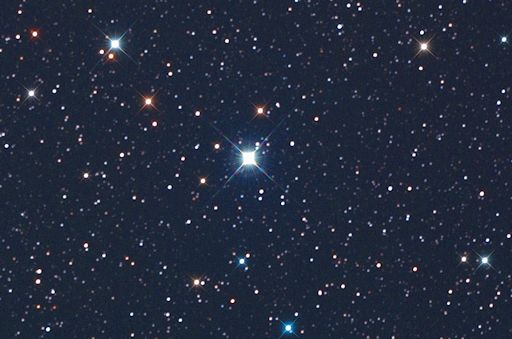QUIET SUN: Solar activity has returned to low levels. New sunspots AR1817 and AR1818 broke the quiet earlier this week with a brief spate of C- and M-class solar flares, but their magnetic fields have since decayed. NOAA forecasters put the odds of an M-class flare today at 30%. Solar flare alerts: text, voice.
A NEW STAR IN THE SKY: Around the world, amateur astronomers are turning their telescopes toward minor constellation Delphinus where a new star has appeared. Koichi Itagaki of Yamagata, Japan, discovered the nova on August 14th. At the time, the stellar brightness was +6.3. Since then it has continued to brighten, possibly crossing the 6th magnitude threshold of naked-eye visibility. John Chumack photographed the surging nova on August 15th from the John Bryan State Park in Yellow Springs, Ohio:
"The nova is hard to see naked eye unless you are in a very dark sky and know exactly where to look," says Chumack, "but this is a very bright nova visible in binoculars." He used a 16-inch Newtonian telescope to take the picture.
Backyard astronomers who wish to see this nova should point their GOTO telescopes to coordinates 20:23:30.7, +20:46:06 (J2000). More information and updates are available from Sky and Telescope.

Solar wind
speed: 588.0 km/sec
density: 1.5 protons/cm3
explanation | more data
Updated: Today at 1936 UT
X-ray Solar Flares
6-hr max: C2 1756 UT Aug15
24-hr: C2 1756 UT Aug15
explanation | more data
Updated: Today at: 1900 UT
![]()
Daily Sun: 15 Aug 13
Sunspots AR1817 and AR1818 pose a threat for M-class solar flares. Credit: SDO/HMI
![]()
Sunspot number: 105
What is the sunspot number?
Updated 15 Aug 2013
Spotless Days
Current Stretch: 0 days
2013 total: 0 days (0%)
2012 total: 0 days (0%)
2011 total: 2 days (<1%)
2010 total: 51 days (14%)
2009 total: 260 days (71%)
Since 2004: 821 days
Typical Solar Min: 486 days
Update 15 Aug 2013
The Radio Sun
10.7 cm flux: 125 sfu
explanation | more data
Updated 15 Aug 2013
![]()
Current Auroral Oval:
Switch to: Europe, USA, New Zealand, Antarctica
Credit: NOAA/POES
![]()
Planetary K-index
Now: Kp= 4 unsettled
24-hr max: Kp= 4 unsettled
explanation | more data
Interplanetary Mag. Field
Btotal: 8.3 nT
Bz: 3.8 nT north
explanation | more data
Updated: Today at 1936 UT
![]()
Coronal Holes: 15 Aug 13
Solar wind flowing from this coronal hole should reach Earth on August 17-18. Credit: SDO/AIA.





